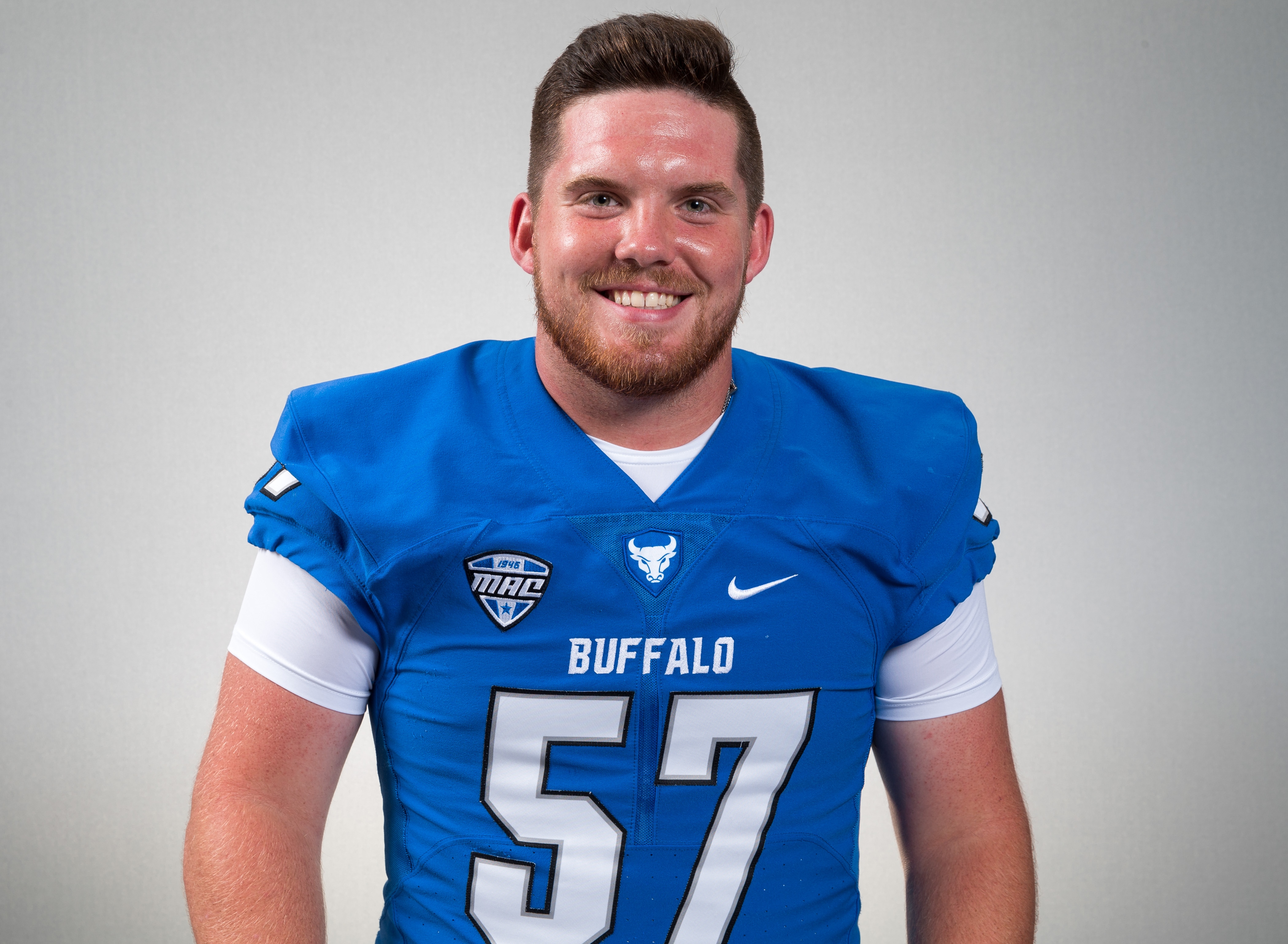In football parlance, the long snapper is a special teams specialist whose duty is to snap the football over a longer distance, typically around 15 yards during punts, and 7 to 8 yards during field goals and extra point attempts.
I never knew such a creature existed. Why, what’s so special about squatting down and passing the ball between your legs? Up to about a decade ago, that was pretty much the thinking in professional and collegiate ranks.
All my thinking changed when I received an email in late November from the Honorable Michael J. Riordan, a judge on the Michigan Court of Appeals, reminding me that the Mid-American Conference championship game (Nov. 27) was going to be staged at Ford Field between the University of Buffalo and Northern Illinois University.
What made it relevant was that his son, Jeremiah, a 2017 graduate of University of Detroit Jesuit High School, was the “starting snapper” for Buffalo, and had been for two years.
Furthermore, according to an attached article, Jeremiah’s snaps to the ball-holder for the kicker had been clocked an average of 6.9 tenths of a second.
Wow! That’s two-thirds of a second, and eighth best in the country!
Almost as fast as the blink of an eye. A complete human blink is about an average of 3 to 4 tenths of a second.
One of the NFL’s most dramatic long-snapping episodes happened in 2003. Both of the New England Patriots' long snappers were injured. They lured Brian Kinchen out of a retirement he had been enjoying for three years after a 13-year career as a tight end and long snapper with four NFL teams.
He joined the team for the last two regular season games and continued that role throughout the playoffs. With 0:09 left to play in Super Bowl XXXVIII, Kinchen snapped the game-winning field goal for the Patriots’ 32-29 victory over the Carolina Panthers.
One of the worst long-snapping catastrophes in NFL history happened on Oct. 26, 2008, in Pittsburgh. With three minutes left in the third quarter, the Steelers’ starting long snapper tore his ACL while covering a punt.
With seven minutes left in the game, Pittsburgh had a fourth-and-22 at their own 18-yard line, leading by two points. They had no choice but to bring out the backup who’d never had to do this in a game before. He failed.
The backup’s snap went a full 28 yards over the head of the punter into and through the end zone for a safety, tying the game. The Steelers eventually lost the game.
That was a defining moment for the NFL, whose 32 teams now set aside a spot on the 53-man roster for a guy whose only job is to snap the ball on field goals, extra points, and punts.
Jeremiah Riordan started playing football for Plymouth Our Lady of Good Counsel’s CYO sixth grade team.
“I was kind of forced to play. In the eighth grade, I began to realize how valuable a center could be to the team,” he says.
It’s not surprising that camps sprung up for this specialty designed for kickers, punters, and long snappers on the professional, collegiate and high school levels.
Riordan, 6-foot-1, 225 pounds, groomed his skills at the nationally renowned Kohl’s Kicking Camp. The usual workout routine consisted of stretching exercises, individual drills with a partner and then repetitive snapping drills to a holder, punter or stationary target.
Attention to technique is all important: a comfortable stance, placement of the hands, position of the arm, and then, the snap.
The snap is made with arms, wrists and hands moving in a continuous motion directly at the target, inside the punter’s kicking hip.
It all comes down to precision. A well-executed snap (timed between .70 and .75 second) on a field goal should take no more than 1.25 seconds from the snapper’s first flinch to the ball leaving the kicker’s foot. On a punt, it shouldn’t take more than 1.9 for the ball to be airborne.
Riordan was the long snapper for three years at U-D Jesuit and earned a long-snapper scholarship – a rarity for such a specialized position – to Buffalo. He has appeared in all 26 contests the Bulls have played the last two years. He’s been busy, too: snapping for 30 field goal attempts, 112 punts and 95 points after touchdowns.
He’s had his pressure-packed moments. He was a freshman in 2017 when Buffalo and Western Michigan engaged in a thrilling seven-overtime battle. Riordan snapped a field goal with two minutes to play in regulation to tie the score, then snapped another field goal in the sixth overtime to give the Bulls a 68-65 lead. Western responded, however, with a touchdown for a 71-68 win.
Against Florida Atlantic, Riordan snapped a field goal at the half to tie the score, spurring the Bulls to an eventual 34-31 win.
(If you're curious, by the way, in that MAC championship game, Buffalo blew a 29-10 lead in the closing 69 seconds to lose to Northern Illinois, 30-29.)
After college, Jeremiah says he’d like to snap in the NFL. The competition is fierce for these very select spots. But if you can make it, the average pro experience for a snapper in 2017 was nearly six seasons, and the average annual salary was a shade under $800,000, with the highest-paid snapper making $1.4 million.

Judge Riordan was a center, too, at Redford Bishop Borgess (Class of 1978). He confessed to me once that he thought about a career as a sportswriter. (Judge, you made the right decision to go into law). He reported a couple of interesting notes in his email.
When Jeremiah snaps the ball to the punter at Buffalo, a fellow Catholic League player is catching it: Evan Finegan, a sophomore from Madison Heights Bishop Foley (2017) and a CYO veteran from Utica St. Lawrence.
In his senior year, Finegan led all high school punters in the state of Michigan with a 44.8-yards-per-punt average. He was fourth-best in the MAC this fall with a 41.8-yard average for 52 punts.
Another CHSL player was on the Northern Illinois squad, a red-shirted freshman, Liam Soraghan, also a Plymouth Good Counsel alum and a 2017 graduate of Dearborn Divine Child, where he was an All-State tight end on offense and linebacker on defense.
I’m still thinking about the speed of the long snaps. The next time you watch a football game, watch for it. But don’t blink. You might miss it.
Contact Don Horkey at dhorkey@wowway.com.










